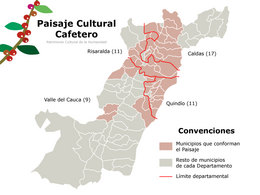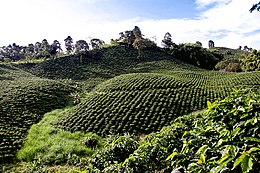Colombian coffee growing axis
This article needs additional citations for verification. (April 2022) |
| UNESCO World Heritage Site | |
|---|---|
 | |
| Location | Colombia |
| Includes | Six zones (A to F) |
| Criteria | Cultural: (v), (vi) |
| Reference | 1121 |
| Inscription | 2011 (35th Session) |
| Area | 141,120 ha (348,700 acres) |
| Buffer zone | 207,000 ha (510,000 acres) |
| Coordinates | 5°28′18″N 75°40′54″W / 5.47167°N 75.68167°W |



The Colombian coffee region (Spanish: Eje Cafetero), also known as the Coffee Triangle (Spanish: Triángulo del Café) is a part of the Paisa region in the rural area of Colombia. It is famous for growing and producing the majority of Colombian coffee. There are four departments in the area: Caldas, Quindío, Risaralda and Tolima. The most visited cities are Manizales, Armenia, Pereira, and Ibagué.
History of coffee
[edit]Coffee was first grown commercially in Colombia in Salazar de las Palmas, north of Santander, and over the twentieth century grew to be Colombia's primary export. When coffee was first brought into the country, the leaders tried to push the farming of coffee beans, but was met with resistance from the people because it takes about 5 years until the first harvest of the bean. In 1999 coffee revenues represented 3.7% of gross domestic product (gdp) and 37% of agricultural employment. The main coffee-producing departments are: Nariño, Norte de Santander, Antioquia, Valle del Cauca, Huila, Tolima, Caldas, Risaralda, Quindio and Cundinamarca.
The area between the departments of Caldas, Risaralda, Quindío and Tolima is known as the Coffee Zone because of the large development experienced by the cultivation of this product. This region was strongly affected by an earthquake that was 6.4 on the Richter scale on January 25, 1999, but subsequently the region's economy recovered rapidly.
Overview
[edit]Weather conditions (8 °C to 24 °C), geographical (Andean Rainforest) and the geological region, determine the production of high quality coffee, with relatively short harvest periods. Farmers in the area have developed techniques for growing, harvesting and processing of grain, and all done "grain by grain", and have retained this form of processing industry despite new techniques of mass agricultural industrialization.
The famous advertising icon "Juan Valdez", represented by a Paisa farmer wearing a carriel, aguadeño hat and poncho, and accompanied by a mule, has become a triumph of advertising communication. Juan Valdez has been considered in United States as the advertising image of greater recall among the inhabitants of that country in the year 2005.
Coffee Cultural Landscape World Heritage Site
[edit]Eighteen urban settlements across six sites within the coffee axis and extending southwards into the Valle del Cauca department were inscribed on the UNESCO World Heritage List in 2011 as the Coffee Cultural Landscape.[1] These sites are representative of the entire coffee axis, preserving multiple different forms of traditional coffee growing, in addition to the culture of the region and the locations of several unique festivals. [2] The World Heritage site is composed of many of the urban centers within the region, including Armenia, Calarcá, Salamina, Pereira, and Riosucio, as well as smaller towns and the surrounding rural coffee farmlands.[1]
Tourist attractions
[edit]


The region has developed major theme parks such as the Colombian National Coffee Park located in the town of Montenegro in Quindio. In the area is also the Museum of Culture Coffee, showing the process from grain production to savoring a traditional Colombian coffee. This museum, like all the other theme parks, are replicas of the colonial city, where tourists enjoy dance performances and traditional music, panoramic views from cable car with its lush landscape, and various rides.
Another unique theme park in Colombia is the National Park of Culture Agriculture - 'Panaca', also located in the Municipality of Quimbaya in Quindio. Its key feature is that, unlike zoos, visitors are immersed in a personal and direct contact with farm animals and also enjoy scheduled activities and events with those animals.
Other attractions in the area include:
- Botanical Garden of the University of Pereira as one of the largest in Colombia as the only listed by the BGCI as natural or Sivestre, but also for being one of the orchid s in the world.
- Santuario is one of the most characteristic towns of the region, is known for its tradition paisa's architecture and streets. It is close to PNN Tatamá.
- Thermal Santa Rosa de Cabal, a "spa" for bathing in hot springs and different activities for relaxation and body care.
- Rafting on the Rio la Vieja: Walking the Rio La Vieja on the border between the departments of Valle del Cauca and Quindío, from the town of Quimbaya
- Cocora Valley in Salento, home of the national tree Palma wax Quindío one of the most beautiful spots around the axis coffee one of the entry points to Los Nevados National Natural Park where there are also entitled to stay and camp sites.
- Quindío Botanical Gardens, located in the town of Calarcá, where you can also see in the butterfly with the largest exhibition of butterflies in the country.
Main urban centers
[edit]- Pereira, Risaralda Department
- Armenia, Quindío Department
- Manizales, Caldas Department
- Ibagué, Tolima Department
Tourism
[edit]- Colombian National Coffee Park Montenegro
- Nevado del Ruiz. Manizales
- PANACA Parque
- Cocora Valley, Salento. Quindío
- Matecaña City Zoo
Tourist excursions offer trekking to some of Colombia's top coffee cultivating land as well as the country's native palm tree - the Wax Palm, which grows up to 60 metres tall.
See also
[edit]- Juan Valdez (International gourmet coffee brand)
- Pereira, Risaralda (Colombian City)
- Armenia, Quindío (Colombian City)
- 1999 Armenia earthquake
- Manizales, Caldas (Colombian City)
- Risaralda (Colombian department)
- Quindío (Colombian department)
- Caldas (Colombian department)
- Ibagué, Tolima Department
- Antioquia (Colombian department)
- Coffee production in Colombia
 Colombia portal
Colombia portal Coffee portal
Coffee portal
Gallery Colombian National Coffee Park
[edit]-
Coffee process museum
-
Panoramic gondola lift
-
Folkloric House
-
Bamboo Forest
-
Antioquia Railway Station
-
Railway Station
-
Aerial View
-
View
-
Statues
References
[edit]- ^ a b "Coffee Cultural Landscape". UNESCO World Heritage List. United Nations Educational, Scientific, and Cultural Organization. Retrieved 25 Apr 2011.
- ^ International Council on Monuments and Sites. Coffee Cultural Landscape (Colombia) No 1121: ICOMOS Evaluation. UNESCO World Heritage List (Report). Retrieved 25 Apr 2011.
External links
[edit]- The region's official tourism portal (in English)
- Coffee region travel page on Colombia Reports Archived 2011-05-31 at the Wayback Machine (in English)
- Coffee region blog on Colombia BnB Colombia Tours Archived 2021-11-30 at the Wayback Machine (in English)
- Coffee region blog "Calarca" on Colombia BnB Colombia Tours Archived 2021-11-30 at the Wayback Machine (in English)
- The Colombian Coffee Zone on The Colombian Way (in English)










